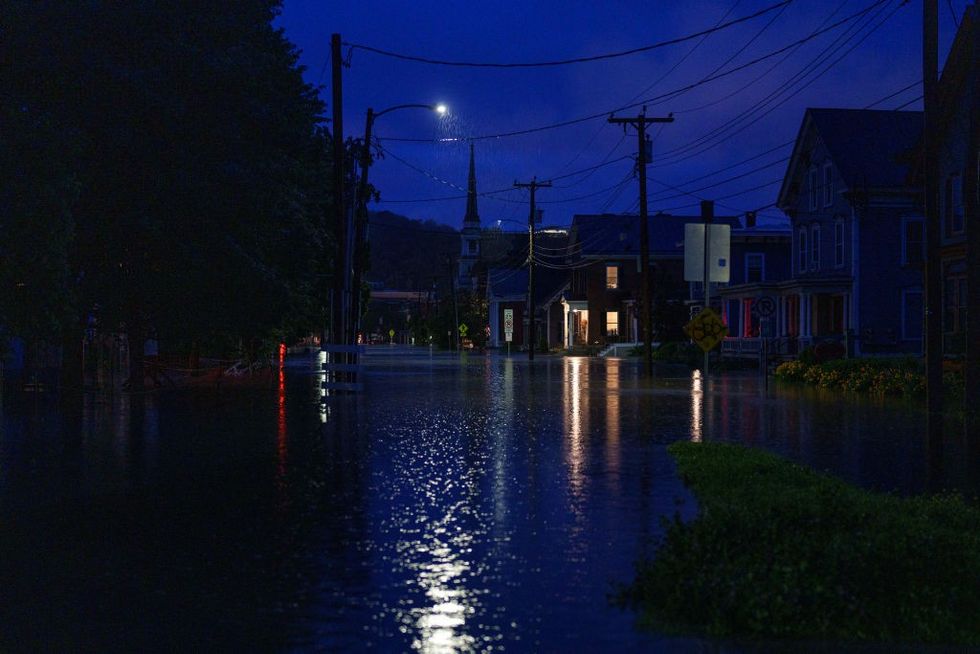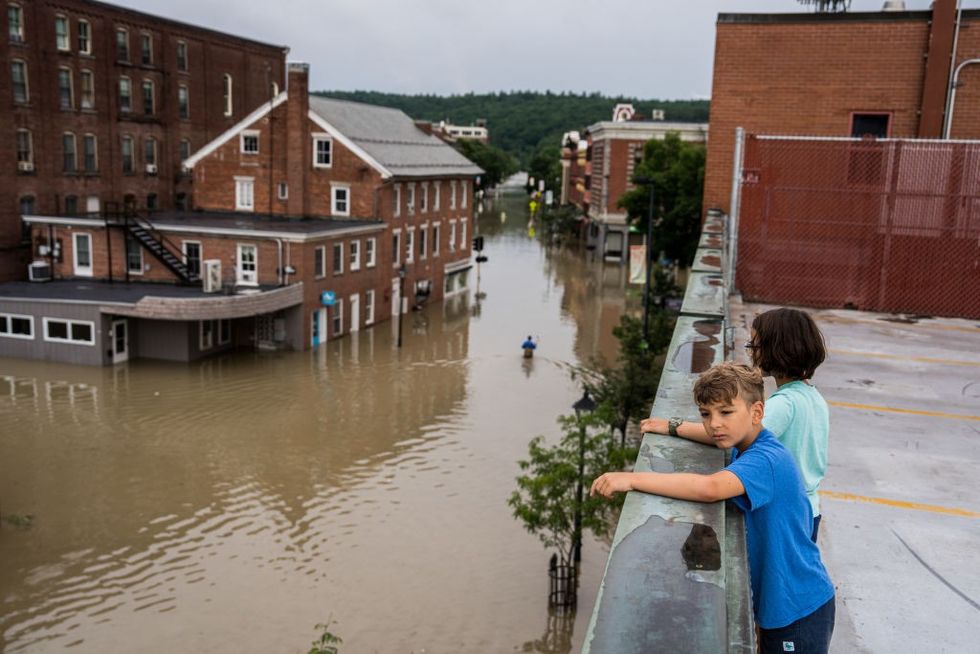

SUBSCRIBE TO OUR FREE NEWSLETTER
Daily news & progressive opinion—funded by the people, not the corporations—delivered straight to your inbox.
5
#000000
#FFFFFF
To donate by check, phone, or other method, see our More Ways to Give page.


Daily news & progressive opinion—funded by the people, not the corporations—delivered straight to your inbox.
The science on climate change is so indisputably well-established, that it’s hard to see how any court would uphold a challenge to it.
In a blitz of destructive actions announced by Environmental Protection Agency Administrator Lee Zeldin last month, he specifically called for a reconsideration of the 2009 Endangerment Finding. A formal proposal for reconsideration of the finding (and all the agency regulations and actions that depend on it) is expected this month.
The science underpinning the Endangerment Finding is airtight, but that won’t stop the Trump administration from setting up a rigged process to try to undo it and give a blank check to polluters. The Union of Concerned Scientists (UCS) will fight back to defend climate science and protect public health safeguards.
In an earlier post, I laid out some of the history and context for the 2009 science-backed Endangerment Finding and the Cause or Contribute Finding. These findings followed from the landmark 2007 Mass v. EPA Supreme Court ruling which held that greenhouse gas (GHG) emissions are unambiguously air pollutants covered by the Clean Air Act. Together, these establish the clear basis for EPA’s authority and responsibility to set pollutions limits for heat-trapping emissions from vehicles, power plants, and other sources of these pollutants, under the Clean Air Act.
There is nothing mysterious about the heat-trapping attributes of greenhouse gases, nor their impact on public health. It’s called science.
Attacks on the Endangerment Finding and EPA’s Clean Air Act authority from industry interests are nothing new. Importantly, courts have repeatedly upheld both, including in a resounding 2012 decision from the U.S. Court of Appeals–D.C. Circuit in Citizens for Responsible Regulation v. EPA. But those who have long sought to overturn or weaken regulations to limit heat-trapping emissions now have Administrator Zeldin in their corner. And he has shown himself to be an unbridled purveyor of disinformation and proponent of harmful attacks on bedrock public health protections, as my colleague Julie McNamara highlights.
The details of what will be included in the reconsideration proposal are unclear at this point. But we do know some of the trumped-up lines of attack the Zeldin EPA could advance to try to invalidate these findings because many of these tired arguments are outlined in EPA’s reconsideration announcement.
Here are the facts:
Every major scientific society endorses the scientific consensus on human-caused climate change driven by GHG emissions. The Fifth National Climate Assessment (NCA5) and the IPCC’s Sixth Assessment Report are two major recent authoritative summaries of peer-reviewed climate science, which show that the science on climate change has only become more dire and compelling since 2009.
The impacts of climate change on human health are also starkly clear and backed by overwhelming evidence. Here’s the main finding from the NCA5 chapter on public health, for instance:
Climate change is harming physical, mental, spiritual, and community health through the increasing frequency and intensity of extreme events, higher incidences of infectious and vector-borne diseases, and declines in food and water security. These impacts worsen social inequities. Emissions reductions, effective adaptation measures, and climate-resilient health systems can protect human health and improve health equity.
As just one example, climate change is contributing to worsening extreme heat, which exerts a punishing toll on people’s health, including that of outdoor workers. Heat is already the leading cause of extreme weather-related deaths in the United States, and studies show that heat-related mortality is on the rise.
Looking around the nation, with communities reeling from extreme heatwaves, intensified hurricanes, catastrophic wildfires, and record flooding, climate impacts are the lived reality of all too many people. To deny that or obfuscate about the underlying causes is not only disingenuous, but actively harmful and outright cruel.
A Finding of Endangerment under the Clean Air Act is specifically focused on a threshold scientific determination of whether the pollutant under consideration harms public health or welfare. Costs to industry of meeting any subsequent regulations are not relevant per the statute.
The original Endangerment Finding was reached in the context of the vehicle emissions, per section 202(a) of the Clean Air Act, partially excerpted below:
The administrator shall by regulation prescribe (and from time to time revise) in accordance with the provisions of this section, standards applicable to the emission of any air pollutant from any class or classes of new motor vehicles or new motor vehicle engines, which in his judgment cause, or contribute to, air pollution which may reasonably be anticipated to endanger public health or welfare.
In its 2012 decision, the D.C. Circuit was also clear is noting that “By employing the verb ‘shall,’ Congress vested a non-discretionary duty in EPA.” That duty is not circumscribed by cost considerations.
Of course, the impacts of climate change are themselves incredibly costly and those costs are mounting as heat-trapping emissions rise. Unsurprisingly, the social cost of greenhouse gases, a science-based estimate of those costs, is another metric that the Trump EPA is seeking to undermine in yet another blatant attempt to put a thumb on the scale in favor of polluting industries.
As noted in the 2009 Endangerment Finding, the EPA defined the pollutant contributing to climate change as “the aggregate group of the well-mixed greenhouse gases” with similar attributes. The attributes include that they are sufficiently long-lived, directly emitted, contribute to climate warming, and are a focus of science and policy.
The EPA used a very well-established scientific methodology to combine emissions of GHGs on the basis of their heat-trapping potential, measured in carbon-dioxide equivalents. In the case of passenger cars, light- and heavy-duty trucks, buses, and motorcycles—the transportation sources EPA considered for the original Endangerment Finding—they emitted four key greenhouse gases: carbon dioxide, methane, nitrous oxide, and hydrofluorocarbons.
False, glib claims in the reconsideration announcement baselessly accuse the 2009 Endangerment Finding of making “creative leaps” and “mysterious” choices. There is nothing mysterious about the heat-trapping attributes of greenhouse gases, nor their impact on public health. It’s called science. Once again, relying on the mountain of evidence in the peer-reviewed scientific literature would make that readily apparent.
The Cause or Contribute Finding—which specifically established that greenhouse gas emissions from new vehicles contribute to the pollution that harms public health—may also come under attack. This finding has been extended to other major sources of GHGs, including power plants and oil and gas operations. However, the Trump administration could attempt to use accounting tricks to avoid regulating emissions—as it has tried before.
In its first term, the administration attempted multiple underhanded maneuvers along these lines, including in the context of methane and volatile organic compound regulations in the oil and gas sector. For these regulations, the administration split up segments of the source category, designated them as separate source categories, used that manipulation to claim inability to regulate certain segments, and asserted that methane emissions from the remaining segments were too small and regulating them would not provide additional benefits, so those too could not be regulated. Separately, in the final days of the administration, EPA released an absurd framework attempting to set thresholds for determining “significance,” trialed in the context of power plants.
This irrational approach could be used to artificially segment components of power plants or the power system, for example, and then claim no regulations are required. This kind of rigged math wouldn’t fool a kindergarten child, but there’s no telling where this administration might go in its desperate attempt to undo or weaken regulations on greenhouse gas emissions.
Under Administrator Zeldin, EPA’s mission to protect public health and the environment has been completely subverted. His shocking rhetoric lays bare how far he will go to protect polluters at the expense of the public. Here he is, for instance, crowing about going after 31+ EPA regulations and guidance, as well as the enforcement of pollution standards meant to protect all of us:
Today is the greatest day of deregulation our nation has seen. We are driving a dagger straight into the heart of the climate change religion…
EPA even set up an email address for polluters to send an email to get a presidential exemption from complying with regulations on toxic pollution, such as mercury emissions, regulated under the Clean Air Act!
Zeldin is fervently committed to dismantling public health protections and rolling back enforcement of existing laws passed by Congress. Going after the Endangerment Finding is an integral part of this all-out assault because, in the Trump administration’s harmful calculation, revoking the finding is a potential means to rolling back all the regulations that depend on it.
Ironically, some utilities and oil and gas companies have spoken out in favor of keeping the finding intact, as they fear a greater risk of climate damages lawsuits in the absence of EPA authority to regulate greenhouse gases. Of course, this just exposes that they know their products are causing damage. What they seek is the weakest possible exercise of EPA authority so they can continue to reap profits while evading accountability for those harms.
But none of this is a foregone conclusion. The legal and scientific basis for the Endangerment Finding is incredibly strong. The false claims Zeldin and other opponents have trotted out are full of bombast but weak on substance.
The science on climate change is so indisputably well-established, that it’s hard to see how any court would uphold a challenge to it. That’s not to say Zeldin won’t try to find a cabal of fringe “scientists” to try to attack it, but they’re unlikely to succeed on the merits.
Public comments on the proposal to reconsider the Endangerment Finding can help set the record straight on facts. And if the Zeldin EPA ignores them and finalizes a sham finding or revokes the finding with a faulty rationale, that will be challenged in court.
UCS will be closely following the details of EPA’s proposal to reconsider the Endangerment Finding when it is released. And we will let you know how you can add your voice to bolster this crucial science-based finding, and the public health protections that flow from it. So, stay tuned!
'For too long, giant fossil fuel companies have knowingly lit the match of climate disruption'
The US Chamber of Commerce and the American Petroleum Institute - representing the biggest fossil fuel companies in the world - are suing the State of Vermont over its new law requiring fossil fuel companies to pay a share of the state's damage caused by climate change.
The lawsuit, filed last Monday in the US District Court for the District of Vermont, asks a state court to prevent Vermont from enforcing the law passed last year. Vermont became the first state in the country to enact the law after it suffered over $1 billion in damages from catastrophic summer flooding and other extreme weather.
Vermont’s Attorney General’s Office said as of Friday, Jan. 3, they had not been served with the lawsuit.
The lawsuit argues that the U.S. Constitution precludes the act and that the federal Clean Air Act preempts state law. It also claims that the law violates domestic and foreign commerce clauses by discriminating “against the important interest of other states by targeting large energy companies located outside of Vermont.”
The Chamber and the American Petroleum Institute argue that the federal government is already addressing climate change. Because greenhouse gases come from billions of individual sources, they claim it has been impossible to measure “accurately and fairly” the impact of emissions from a particular entity in a specific location over decades.
“For too long, giant fossil fuel companies have knowingly lit the match of climate disruption without being required to do a thing to put out the fire,” Paul Burns, executive director of the Vermont Public Interest Research Group, said in a statement. “Finally, maybe for the first time anywhere, Vermont is going to hold the companies most responsible for climate-driven floods, fires and heat waves financially accountable for a fair share of the damages they’ve caused.”
The complaint is an essential legal test as more states consider holding fossil fuels liable for expensive global warming-intensified events like floods, fires, and more. Maryland and Massachusetts are among the states expected to pursue similar legislation, modeled after the federal law known as Superfund, in 2025.
New York Gov. Kathy Hochul (D) signed a similar climate bill into law - the Climate Change Superfund Act- on Dec. 26, pointing to the need to fund climate adaptation projects.



"Air pollution standards must protect endangered plants and wildlife, but the agency failed to follow the law, or the science, to fully address this toxic air pollution's harms to the environment," said one attorney.
The Center for Biological Diversity on Monday lamented what it called the Biden administration's failure to improve "outdated" limits on nitrogen and soot air pollution.
The U.S. Environmental Protection Agency (EPA) proposed keeping existing secondary national ambient air quality standards for sulfur and nitrogen oxides after estimating that new benchmarks previously put forth would result in reduced pollution from sources including coal-fired power plants.
However, Center for Biological Diversity (CBD) staff attorney Ryan Maher argued that "the EPA failed to seize this important opportunity to better protect plants and animals from these toxic pollutants."
"Since the EPA's last review of these pollution standards, the science showing the ecological harm from soot, sulfur, and nitrogen air pollution has become more certain."
"Since the EPA's last review of these pollution standards, the science showing the ecological harm from soot, sulfur, and nitrogen air pollution has become more certain," Maher added. "Rather than aligning its standards with this new research, the EPA has chosen to perpetuate dangerous levels of air pollution."
The Clean Air Act requires the EPA to set primary, or health-based, and secondary, or welfare-based, "national ambient air quality standards" for pollutants including sulfur oxides, nitrogen oxides, and particulate matter—better known as soot. However, the EPA has failed to update the secondary standards for nitrogen and sulfur air pollution for more than half a century. Key portions of the EPA's secondary soot standards also haven't been updated in decades.
According to the CBD:
The agency published today's proposal under an agreement that resulted from a 2022 lawsuit brought by the Center for Biological Diversity and the Center for Environmental Health. That agreement requires the agency to finalize its decision on the air quality standards no later than December 10, 2024.
The agency will hold a virtual public hearing on the proposed rule on May 8.
Critics have also called out the EPA for not completing a mandatory Endangered Species Act consultation with the U.S. Fish and Wildlife Service and National Marine Fisheries Services about how pollution levels allowed under the proposed standards could harm endangered plants and animals.
"Air pollution standards must protect endangered plants and wildlife, but the agency failed to follow the law, or the science, to fully address this toxic air pollution's harms to the environment," Maher noted.
Separately, green groups including Earthjustice, Sierra Club, California Communities Against Toxins, and Southwestern Environmental Law Center on Monday welcomed the EPA's decision to deny an industry petition to delist energy turbines as a major source of air pollution.
"Today's decision upholds critical environmental protections that are essential for safeguarding public health, particularly in communities that have historically borne the brunt of industrial pollution," Earthjustice director of federal clean air practice James Pew said in a statement.
"Keeping pollution control requirements in place is not just a matter of regulatory compliance; it's a fundamental environmental justice issue," Pew added. "EPA did the right thing by rejecting industry's attempt to dodge these requirements and get a free pass to pollute."